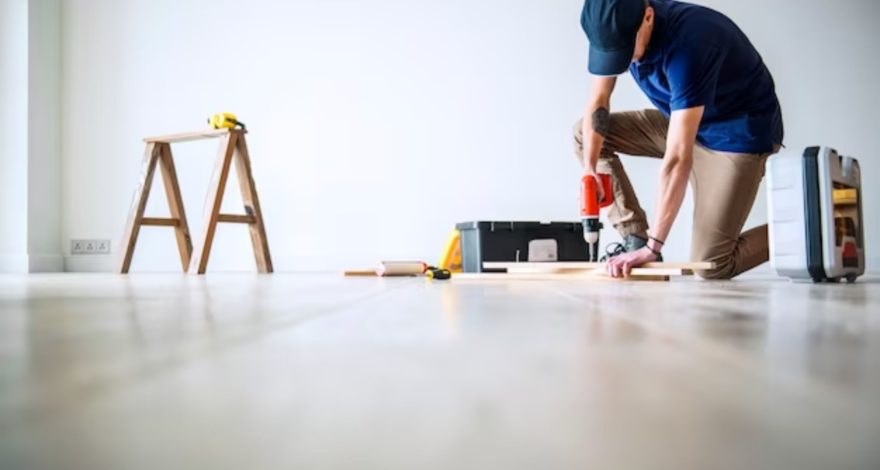Just like wood needs sanding to become smooth and appealing, concrete floors can also be transformed. Sanding and polishing concrete is a game-changer for homeowners and DIY enthusiasts. Through professional floor sanding Melbourne services, we can turn rough surfaces into a sleek, shiny masterpiece.
It’s a simple yet effective method to enhance the look and feel of any space. Whether you’re a DIY enthusiast or want to grab knowledge before hiring professionals, this blog post is crafted for you.
Our seven easy steps to sand and polish concrete floors are designed to guide you through the process from start to finish.
Ready to make your concrete floors look amazing? Let’s dive in!
Concrete Sanding and Polishing in 7 Easy Steps
Don’t even think about starting without these tools
- Concrete Floor sander and polisher
- Grinding Pads and Discs
- Polishing Pads
- Chemical concrete hardener
- Burnishing Machine or High-Speed Buffer
Inspect and evaluate before polishing and sanding
To start concrete sanding and polishing, assessing the concrete’s hardness is crucial. This determination dictates the equipment needed and impacts the duration of sanding. Testing various abrasives, sandpapers, or diamond pads reveals the concrete’s nature.
Softer surfaces require fewer abrasive tools and less time. However, meticulous attention is necessary to prevent excessive material removal.
If the surface exhibits porosity, cracks, or blemishes, repair them using a concrete crack filler or epoxy-based material. Once dry, proceed to the next step: surface cleaning.
For mildly stained surfaces, you can use water and household detergent. Stubborn stains may necessitate Hydrogen Peroxide, TSP, or Ammonia.
Caution: Avoid mixing chemicals to prevent unintended reactions, surface damage, or personal harm. Here, you may need expert guidance because professional floor sanding and polishing Melbourne experts know where to use chemicals and where not to.
Choose the proper tools can make sanding concrete easier and faster
Choosing the right equipment is key to efficiently sanding concrete. Here’s a guide to help you choose wisely.
Polishing Pads and Diamond Sandpaper
For minor touch-ups, manual sanding with polishing pads or diamond sandpaper is effective. Avoid standard sandpaper as it lacks the durability for cement surfaces. Start with a coarse grit, progressively moving to finer grits for a smooth, polished surface. This method is ideal for minor corrections, such as filling cracks or smoothing small holes.
– Ideal for: Minor repairs on surfaces like cracks or small holes.
Handheld Concrete Sanders
These compact, electrically powered sanders offer versatility with adjustable speeds and, sometimes, water supply features. Their size allows for easy handling, especially useful for detailed work around edges or tight spaces. Handheld sanders are perfect for smaller, flat surfaces such as bathroom floors or kitchen countertops, although they might be less effective for vertical applications.
– Ideal for: Small, flat surfaces like bathroom floors and kitchen countertops.
Belt Sanders
Belt sanders, equipped with a continuous loop of sandpaper, are powerful tools for swiftly sanding down large areas. They’re especially suited for expansive spaces like garage floors. However, their aggressive sanding action may leave marks, suggesting a need for a final touch-up with a more delicate tool, such as a handheld sander, for a flawless finish.
– Ideal for: Large, flat areas such as garage floors.
Orbital Sanders
These handheld devices operate in a random orbital pattern, allowing for sanding in any direction. This versatility makes them suitable for a variety of projects, including small-scale tasks and final smoothing operations. Orbital sanders are particularly good for achieving a polished finish on bathroom floors or kitchen countertops without leaving swirl marks.
– Ideal for: Small projects and finishing touches on floors and countertops.
Floor Concrete Grinders
For tackling large outdoor areas, floor concrete grinders are the go-to machines. These hefty, electrically powered units come with rotating polishing pads and are designed for the user to walk behind, pushing the machine forward. This feature makes them perfect for sanding expansive outdoor surfaces like driveways and patios, efficiently covering large areas. Some models offer adjustable handles, enabling easy switching between sanding and polishing modes.
– Ideal for: Large outdoor surfaces, including driveways and patios.
Choosing the appropriate tool for your concrete sanding project not only simplifies the task but also ensures a more professional finish. Whether you’re working on a small repair or refinishing a large surface, there’s a tool designed to make the job easier and more effective.
Prepare the Room and Yourself for Sanding Concrete
Sanding concrete can be quite messy. Opting for wet sanding might seem like a dust-free solution, but it creates a liquid mixture of water and cement dust, which solidifies as it dries.
To safeguard your surroundings, cover objects with plastic and promptly wipe away any spilled concrete-water liquid before it sets.
When dry-grinding concrete, it’s essential to wear protective gear. The level of dust generated varies depending on the type of grinder used. Some grinders come equipped with dust collection systems, effectively minimising airborne particles.
However, even with these systems, a small amount of dust may still be present. Conversely, grinders lacking dust collection systems produce significantly more dust.
For safety, always wear an approved dust mask and goggles. Ear protectors can be worn if necessary, and a paper dust suit can shield your clothing. Ensure your footwear provides ample grip to prevent slips and falls during the process.
Taking these precautions will help you work safely and efficiently when sanding concrete.
Start Sanding Concrete floors
Preparing to sand concrete floors involves several key steps to ensure a smooth and successful process. First, gather all necessary equipment, including a concrete grinder, protective gear such as a dust mask, goggles, and gloves, as well as plastic sheeting to cover surrounding objects.
Begin by thoroughly cleaning the concrete surface to remove any dirt, debris, or grease. This ensures optimal sanding results and prevents damage to the grinder.
Next, inspect the area for any cracks or imperfections that may need to be patched or repaired before sanding.
Once the surface is clean and smooth, it’s time to start sanding. If using a wet sanding method, prepare the concrete grinder by filling the water tank and adjusting the settings as needed.
Begin sanding in one corner of the room, working methodically in small sections to ensure even coverage.
For dry grinding, double-check that the grinder’s dust collection system is properly set up and functioning. Then, start sanding in the same manner as with wet sanding, paying close attention to the amount of dust generated.
Throughout the sanding process, periodically inspect the surface for any areas that may require additional attention or touch-ups.
Once complete, clean up any remaining dust and debris, and allow the floor to dry completely before proceeding with any further treatments or finishes.
Apply Liquid Chemical Hardener
A Densifier enhances the strength and longevity of your concrete surfaces. It’s suitable for use at any phase of the polishing journey, depending on the concrete’s hardness level.
Generally, for surfaces of low to medium hardness, it’s advisable to apply the densifier after the initial rough grind (for instance, using 80 grit).
In the case of harder concrete, applying it following a finer grind (for instance, with 200 grit) is adequate. The application of the hardener is typically done using a sprayer, though alternative methods are available for your selection.
Ensure it is fully dried before proceeding with further sanding or polishing activities. For detailed application instructions, consult the product’s labelling on the container or bottle.
This procedure boosts the concrete’s resistance and durability. While there may be debates on its necessity across all scenarios, it’s particularly advocated for aging concrete items and those prone to porosity.
Complete the Polishing
For polished concrete floors, use 3000-grit pads for the ultimate shine, ensuring a mirror-like surface.
Ensure thorough coverage across the piece for an even aesthetic. Then, clean the space with a vacuum to cut debris before the application of a protective layer.
Applying a top layer of concrete sealant safeguards surfaces like countertops, floors, or walkways against stains and deterioration. It additionally shields the concrete mix from harm caused by accidental spills of chemicals or fluids.
This meticulous approach guarantees the enduring beauty and resilience of the treated surfaces.
Buffing polished concrete floors
You may wonder how to buff polished concrete floors. So yes, buffing polished concrete floors requires a systematic approach for optimal results.
Start by choosing the right buffer. High-speed machines offer the best results. Ensure the floor is clean. Remove dust and debris first.
Select a fine-grit diamond pad. This is crucial for a smooth finish. Attach the pad to the buffer carefully. Check for secure attachments before starting.
Begin at one corner of the room. Move in a systematic pattern. Overlap your passes for even polishing. Keep the buffer moving. Staying too long in one spot can cause damage.
Apply a concrete floor polish. Use a product designed for polished concrete. Spread it evenly across the floor. Follow the manufacturer’s instructions for the best outcome.
Buff the floor until it shines. The process may take several passes. Be patient for a glossy finish.
After buffing, clean the floor again. Use a microfiber mop to remove any polish residue. Allow the floor to dry completely.
Regular maintenance is key. Dust mop daily. Clean spills immediately. This prevents damage and maintains shine.
Buffing not only restores lustre. It also extends the floor’s lifespan. With proper care, polished concrete remains durable and attractive for years.
How to Take Action Today Without Delay
Taking action today without delay can transform your concrete floors from dull to dazzling.
Whether you choose the DIY route or opt to hire professional floor sanding in Melbourne, the key is starting now.
DIY projects can be rewarding, offering a sense of accomplishment and a personal touch to your space. However, they require time, effort, and the right tools.
On the other hand, hiring professionals guarantees a high-quality finish, expertise, and efficiency, saving you time and potential mishaps.
If you’re leaning towards expertise and flawless results, consider Total Floor Sanding and Polishing. Our team of experts ensures your floors not only shine but also reflect the quality and care you value in your home or business.
Make the decision today, and let us bring your floors to life.


